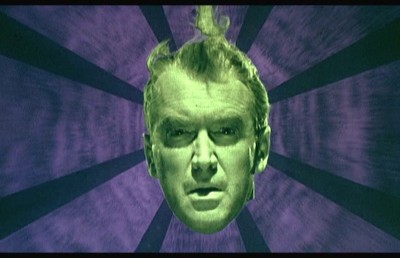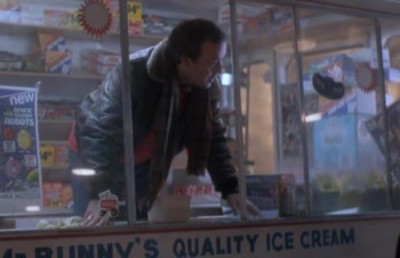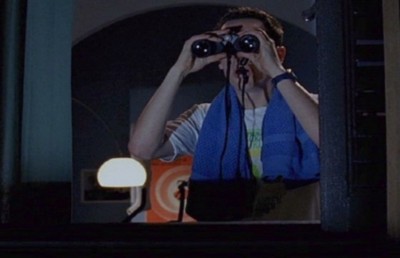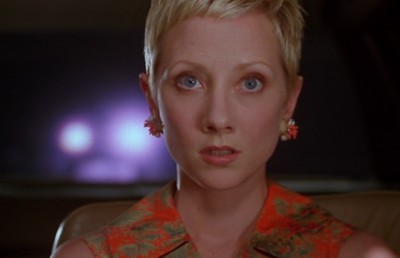The Alan Clarke Collection
Blue Underground DVD Collection
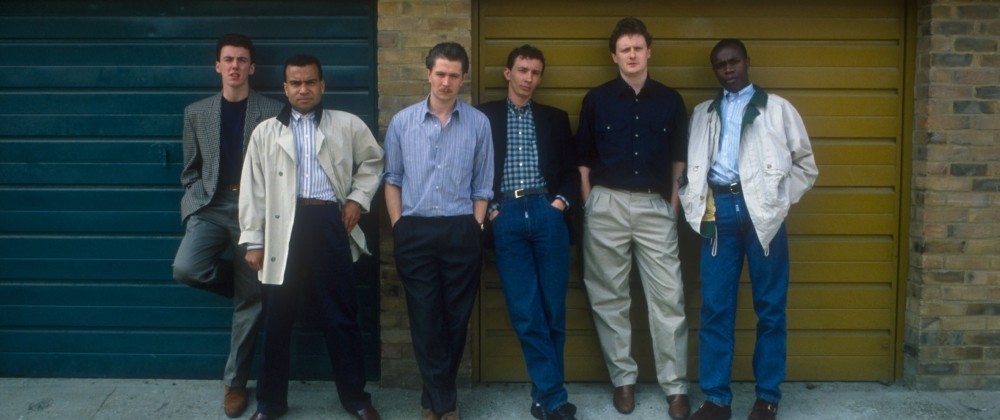
Like such prominent British figures as Ken Loach, Mike Leigh and Stephen Frears, Alan Clarke emerged as a filmmaker in the late sixties, made crucial contributions to the artistry of British television film in the 70s and created seminal works of the Thatcher era, such as Made In Britain (1982), Rita, Sue and Bob, Too (1986), and The Firm (1988). But unlike his aforementioned peers, Clarke is not as widely known outside of Britain, and up until recently only a minute fraction of his creative oeuvre has been accessible. Yet for many Clarke is something of a legendary figure, one whose work has not only been a source of inspiration for individual filmmakers and actors, but can also be seen as pivotal in the evolution from sixties New Wave realism to the provocational, anti-Thatcherist strand of British cinema in the 80s. With his untimely death in 1990, Clarke’s meteoric career was cut short well before enough of his own works were sufficiently accessible to make even a tentative assessment of his stature possible.
Applause, therefore, must go to Blue Underground’s initiative in releasing The Alan Clarke Collection, a five-disc box set of several key works by the director, supplemented by “extras” of varying quality. The set includes the television version of Scum (1977), Clarke’s most notorious work first commissioned then banned by the BBC; the theatrical film version of Scum (1979); Made in Britain; The Firm; and a true rarity, Elephant (1988), a chilling exploration of sectarian violence in Ireland.
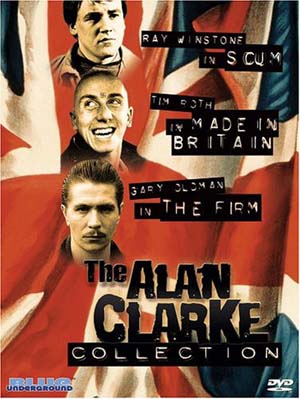
For any cineaste new to Clark’s work, a recommended starting point to the collection is the disc which contains Director: Alan Clarke (1991), a BBC documentary on the director originally released to coincide with a season of Clarke’s works which finally aired on the BBC after his death. Typically of many BBC documentaries the work is rather dry in tone, but highly informative. Clarke was born in Seacombe, near Liverpool, in 1935. As a young man he emigrated to Canada, and, after taking a degree in Radio and Television Arts he returned to England in 1961. Like Mike Leigh, he began his serious creative life as a director of plays, then, in 1967 made four television plays for Associated Rediffusion’s ‘Half Hour Story’ series. For the remainder of the 60s and well into the 70s Clarke directed individual plays and occasional series episodes for both the BBC and various independent television producers. One of the highlights of the BBC documentary on Clarke are tantalizing clips that offer ample evidence of Clarke’s bold originality as a maker of television films. In To Encourage the Others (1972) he tackles the subject of the infamous Bentley case that rocked British society in the 1950s, anticipating Peter Medak’s treatment of the subject in Let Him Have It (1991) by almost twenty years. Pender’s Fen (1974) contains a surreal dream sequence worthy of Buñuel, in which children calmly line up to have their hands chopped off by a rather kindly, avuncular looking axe-wielder.
Scum. The blunt, single word title of Clarke’s most notorious work certainly anticipates the film’s brutal tone. Written by Roy Minton and filmed in an abandoned home for the elderly, the television version of Scum takes an uncompromising, documentary style look at life for boys in a typical British borstal, and is a powerful indictment of the dehumanization that such institutions engender. Certainly this film is not for the squeamish. Inmates are slapped, punched, kicked, bludgeoned and otherwise mistreated in myriad ways, such as being forced to bathe in water that is too hot. Yet, as the BBC documentary on Clarke astutely points out, Scum is typical of Clarke’s work in containing moments of poignant stillness and even of humor amidst the pervading violent gloom. In one celebrated scene Archer (played brilliantly by David Threlfall) is asked by another, illiterate inmate to read a letter from home for him. Archer’s initial reluctance to do the favour and his eventual capitulation charts in miniature the sad arc of dehumanization and the struggle against it that makes the film so moving.
I initially found it promising when I read that the voice-over commentary for the television version of Scum would be by two actors from the film (Phil Daniels and David Threlfall) and the film’s producer (Margaret Matheson). Clarke is a consummate director of actors, as illustrated by Ray Winstone’s career making performance as the central character in both versions of Scum, Tim Roth’s intense, tightly wound performance as a skinhead in Made in Britain and Gary Oldman’s equally chilling portrayal in The Firm of a successful, “respectable” middle class businessman who also happens to be a savage football hooligan. Yet, the commentary for the television version of Scum disappoints, pervaded as it is by comments from the actors admitting that they have forgotten many of the details of the film in general and of their own performances in particular. While this is refreshingly honest it is hardly informative. On a separate track, Ray Winstone offers commentary on two key scenes from this version of Scum, and his intriguing observations give a tantalizing sense of how interesting a sustained commentary by one or more of the film’s actors could have been.
One of the most pedagogically interesting aspects of the Alan Clarke Collection is the opportunity it affords to compare the television version of Scum with the theatrical film version of the same work. How strange it must have been for Clarke to have ended up working on a theatrical version of the same material so soon after completing the television version which the BBC had greenlighted then pulled from being aired just prior to its scheduled release. The theatrical version of the work follows the original quite closely in a number of ways. Ray Winstone again plays Carlin, the new inmate to the Borstal who quickly supplants the inmate who had been the established “daddy” among the boys. The script, again by Roy Minton, contains close echoes of the original and several key set piece scenes (such as the game of murder ball which erupts into racist violence) are reprised. And this version of Scum is arguably even more emotionally wrenching. There are two suicides in the theatrical version as opposed to one in the original, and a scene in which a young inmate is gang raped by three older boys is more graphic and prolonged than the parallel scene in the original version. Yet, the theatrical version of Scum is ultimately inferior to the original, making for an even keener sense of loss over the banning of the television version of this milestone work. The noticeably higher production values of the theatrical version actually work against the achievement of the atmosphere of raw bleakness that typifies the original’s low budget aesthetics. An even more subtle difference has to do with the way the theatrical version, for all it’s emotional power, often seems manipulative of the audience. Such manipulation is particularly evident in the character of Archer (played in this version by Mick Ford) who seems more of a mouthpiece here for didactic messages about the ineffectuality of borstals. At its best, as in the television version of Scum, Clarke’s work is as intellectually challenging as it is emotionally forceful, and the very absence of a didactic, moralizing point of view is what gives much of his work the power to disturb.
Brief mention must be made of the important “extra” on the disc containing the theatrical version of Scum, a running commentary on the work by Ray Winstone. According to the BBC documentary on Alan Clarke, Winstone felt uncomfortable with a scene in the original version in which Carlin nominates another boy to serve him sexually, while emphatically claiming not to be a “poof.” One can’t help but wonder if Winstone’s sensitivity on this matter led to his preference for doing the commentary for the theatrical version, which does not contain the scene. Regardless, Winstone’s observations, though delivered in his gruff vernacular, are the insights of a consummate actor, perhaps one of Britain’s finest. As a commentator Winstone is by turns amusing and provoking, and his refreshingly unpretentious insights about the film and his beloved “Clarkie” make a nice alternative to the sometimes rather dry exegesis of scholarly voice-overs.
Made in Britain and The Firm offer further evidence of Alan Clarke’s adept handling of actors and of just how accurately he had taken the pulse of the times. In Made In Britain Tim Roth makes his film debut as Trevor, a savage, nihilistic skinhead. Yes, Trevor is a racist, violent thug. But under Clarke’s guidance Roth creates a complex character who shows just enough signs of sensitivity and intelligence to make it difficult for us to totally dismiss him. In retrospect, Made In Britain can be seen to have anticipated the iconic importance of the skinhead in subsequent British films like My Beautiful Laundrette (1985), and Sid and Nancy (1986). Yet, unlike the ultimately redeemed figure of Johnny in My Beautiful Laundrette, Trevor is a far more challenging character for the viewer to deal with, his sympathetic qualities more deeply buried. As Clarke realizes, when viewers are confronted with a character like Trevor they are being challenged to grapple with a part of themselves, with the very nature of the social fabric which has made Trevor possible. Trevor’s fascism is mirrored by a society bent on authoritarian control, and his disgusting racism typifies a strand of British sentiment during the Thatcher era given voice by such groups as the National Front.
The voice over commentary for Made In Britain by actor Tim Roth is an improvement over the commentary for the television version of Scum, but ultimately still disappoints. Like many fine actors, Tim Roth is not particularly self-analytical with regard to the acting process. Indeed, early in the commentary, he jokingly refers to method acting as “methodism” and suggests that neither he nor Alan Clarke subscribed to it. But Roth does have a few interesting things to say about Clarke’s working methods. He draws our attention to the almost perpetual use of the steadicam in Made In Britain and to Clarke’s tight relationship with his cinematographer, Chris Menges, rightly suggesting that Clarke was an early pioneer of the use of the steadicam in television. Roth also discusses Clarke’s method of working with actors, including a penchant for long rehearsals, and numerous takes. But the actor also points out a subtle distinction between Clarke and Mike Leigh, who Roth worked with on Meantime (84) directly after making Made In Britain. Where Clarke did not encourage actors to stay in character between takes, and indeed was the provocateur of a good deal of comic hijinks among the crew when the cameras weren’t rolling, Leigh tended to delineate strict parameters for when an actor should be in character and maintained a more emotionally draining intensity of focus.
Like so many of Clarke’s works, his final work, The Firm (1989) affords no easy answers to the enigma that is Bex, played brilliantly by Gary Oldman. In the film Bex is a successful real estate agent with a wife and child. By his own admission, Bex is addicted to the “buzz” of being the head of a firm, a group of local football hooligans. The very fact that Bex’s savagery coexists with a superficial veneer of respectability forces the viewer to mediate on the very tenuousness of “civilized” behaviour. And, again, Clarke’s vision is prophetic, not only of interest in hooliganism as a cultural phenomenon in such books as Bill Buford’s masterpiece of reportage Among the Thugs (1992) but also in the treatment of football obsession in Nick Hornby’s memoir Fever Pitch and the two film versions that it inspired. Anyone wanting to get a quick sense of Clarke’s unflinching honesty and how it clashes with the Hollywood vision of experience would do well to watch a double feature of The Firm and the most recent, pallid film version of Fever Pitch (2005) starring Drew Barrymore and Jimmy Fallon. A final, incidental pleasure of The Firm that should be mentioned is the opportunity it affords of watching two of Britain’s finest character actors, Lesley Manville (who plays Bex’s suffering wife) and Phil Davis, (who plays Yeti, Bex’s sadistic rival). Both, of course, went on to perform in many of the key British films of the 80s, as well as being regulars in Mike Leigh’s stock company.
For me, the hidden gem of The Alan Clarke collection is Elephant one of a number of works by Clarke to focus on the sectarian violence in Northern Ireland. In the film, Clarke dramatically re-enacts a series of sectarian killings, showing them in succession and with no voice-over commentary to anchor the viewer’s point of view. Unlike, say, Mike Leigh’s Four Days in July (1985) which explores the troubles by a close focus on two families, one Catholic and one Protestant, Clarke strips the action of context, presenting the killings in all their brutal, chilling anonymity. As a result, this film virtually tests the limits of documentary realism and is certainly theoretically interesting with respect to the problem of depicting violence in the cinema. On one level, it is certainly easy to take from the film the point that violence of this kind just becomes a numbing, vicious circle. This notion is particularly underscored by the careful way that Clarke structures each sequence. Initially, the steadicam is brilliantly used to closely follow an anonymous assassin on the move towards his appointed goal, in a manner that encourages our identification with that character. After the killing, though, movement gives way to stasis, and we are forced to transfer our identification to the victim of a given killing in a still shot, held for an uncomfortably long duration. As the pattern of oscillation between complicity and judgement repeats itself, the distinction between killer and victim blurs in turn, and the nightmare of this particular pattern of violence is made clear.
But, in this film and other works by Clarke, there is a nagging sense that violence in humans is not just a response to social ills, but may indeed be ingrained. Whereas Ken Loach almost always conveys a strong sense of anti-social behaviour having its roots in problems with social institutions, Clarke sometimes seems like a director whose vision has penetrated into the darkest recesses of the human animal. For example, in Scum it is easy to see how the brutal treatment of the boys by the borstal guards would create a hopeless environment in which violence by the boys, in turn, seems the best defence. But are the guards inherently violent or have they been dehumanized by the nature of their jobs? Put another way, when the guards go home from work are they just as brutal and sadistic as when they are at the borstal? Or like the central characters of Made In Britain and The Firm, are they walking contradictions, people in whom the capacity for savagery and vulnerability strangely coexist? And does the fact that Clarke focuses almost exclusively on male realms with violence at their core suggest that his vision is a feminist critique of male savagery, or does the virtual absence of women, except as victims of male aggression (as in The Firm) suggest a misogynist director out of touch with female experience? Difficult questions, these, and it is a testimony to the complexity of Clarke’s work that it poses such challenges without resorting to easy solutions.
One of the highlights of the BBC documentary on Clarke are the snippets of interview footage with Stephen Frears, who is insightful about Clarke’s work and deeply moving in his description of Clarke’s final days. At one point Frears says of Clarke: “He was the best of us all.” On the evidence of this Blue Underground collection, Frear’s statement constitutes an evaluation that is far from exaggerated, and there is ample evidence here that Clarke was a key film artist of his generation, arguably in the same league as Ken Loach and Mike Leigh. Now some intrepid distributor should be encouraged to prepare a North American DVD release of Rita, Sue and Bob, Too (1986), Clarke’s darkly comic meditation on relationships among the working class in Thatcher era Yorkshire. While awaiting that event we can console ourselves with the very rich, though disturbing pleasures to be gained from this fine Blue Underground primer on Alan Clarke’s work.


